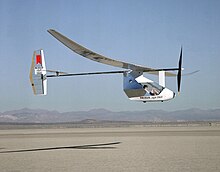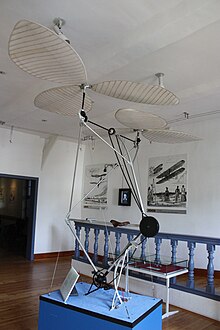Muscular strength plane

A muscle power aircraft ( HPA or MPA , from English human powered aircraft or man powered aircraft ) is an aircraft that is propelled only with the help of the muscle power of the pilot using the gliding properties of the aircraft construction.
boundary conditions
Since the human muscles, unlike, for example, the flight muscles in birds, are not able to provide high specific performance in the long term, i.e. without long recovery phases, an aircraft operated by means of human muscle power must
- a low overall weight
- a high glide ratio
exhibit. These goals require extremely lightweight construction . Functional muscle-powered aircraft were only possible through the use of light, stable films made of biaxially oriented polyester film . Carbon fiber-reinforced plastic is also often used for structural elements.
history


- In his book De motu animalium , published in 1680, the Italian scholar Giovanni Alfonso Borelli calculated that human muscles did not have enough strength to fly like a bird.
- Hermann von Helmholtz came to a similar conclusion . In 1873 he stated in a lecture to the Prussian Academy of Sciences that “it can hardly be regarded as likely that a person would be able to move by the most skilful wing-like mechanism that he would have to move with his own muscle power would be to lift his own weight up and keep it there ”.
- In 1934, the chief engineer Engelbert Zaschka from Berlin recognized that a large wingspan was crucial for a flight with muscle power. Therefore, he equipped his construction with a 20 meter long, narrow wing. The wing was provided with a wire-supported vertical king post (collar beam). A system that was later used very successfully at HPAs . The frame of the Zaschka muscle power aircraft was made of steel tubes, so that it could be accelerated evenly to the nominal airspeed by up to four men. During flight attempts on July 11, 1934, Engelbert Zaschka was able to achieve hovering flights of 20 meters in length in Tempelhof without outside help.
- In 1933 the engineers Haeßler and Villinger , who were employed by Junkers Flugzeugwerke in Dessau at the time , built a muscle -powered aircraft , the HV-1 Mufli , with which the glider pilot Karl Dünnebeil at Frankfurt-Rebstock airport on August 30, 1935 a flight range of Reached 235 meters. 120 flights were carried out, the longest being 712 meters in 1937. However, the launch took place with a tensioned catapult cable and was therefore not exclusively operated by humans.
- In 1936, the German inventor and designer Hans Seehase undertook test flights in a muscle power aircraft he had developed, with which he undertook flights of up to 90 meters - but he was not given any further take-off permission for places with a solid surface, as the tests were shortly before the start of the war were not militarily important.
- In March 1937, a team of Enea Bossi, Vittorio Bonomi (builder) and Emilio Casco (pilot) faced a challenge from the Italian government, one kilometer flight with their Pedaliante. The plane apparently flew short distances entirely under human power, but the distances were not significant enough to win the competition award. Additionally, there have been many disputes over whether it ever took off under the pilot's pedaling power alone, especially since there is no record of this being officially observed.
- In 1959, industrialist Henry Kremer offered the first Kremer Prize of £ 5,000 for the first human-powered aircraft to fly a figure-eight course of two marks half a mile apart. The prerequisite was that the designer, the pilot, the construction site and the flight were British. In 1973, Kremer raised the price to £ 50,000 and opened it to all nationalities to pique interest.
- The SUMPA (Southampton University Man Powered Aircraft) is a muscle powered aircraft that took off on November 9, 1961 for the first successful and documented flight of an aircraft powered only by muscle power.
- The Hatfield Puffin , a muscle power aircraft, was developed by a team led by John Wimpenny and built by volunteers at the Hatfield Aircraft Plant. On May 2, 1962, 39-year-old John Wimpenny climbed up in the Puffin after cycling a hundred meters. He needed about two minutes for the flight distance of 900 meters. This world record was broken only after ten years.
- However, since the available materials were not suitable and the technical possibilities, for example a computer calculation, were not available at this time, these aircraft did not bring any significant progress. When Henry Kremer suspended his award in 1959, it was almost two decades before a muscle-powered aircraft could win the award. Only with the help of computer- calculated profiles and after developing new materials, such as the extremely light but high-strength carbon fiber rods, a wafer-thin film ( Mylar ) and pressure-resistant foams, this project was successful.
- On August 23, 1977, the Gossamer Condor , built by a team under Paul McCready and piloted by Bryan Allen, won the Kremer Prize for continuous controlled flight with muscle power. The condition was a flight with a muscle power aircraft in the shape of a recumbent figure eight 800 meters apart within eight minutes.
- June 12, 1979: Bryan Allen crossed the English Channel between Folkestone and Cap Gris-Nez, distance 35.8 km, in 2:49 hours by plane Gossamer Albatross . The weight of the aircraft was 32 kg with a total weight of 100 kg.
- Pelargos 1983, wingspan: 26 m, weight: 36 kg, flight distance: 800 m (airfield runway length). Muscle power aircraft built in Switzerland by Max Horlacher.
- Musculair 2, built in 1985, a lightweight and muscle-powered aircraft with which Holger Rochelt, the son of the designer Günther Rochelt , set a world record for this special aircraft type at the Schleissheim airfield near Munich with an average speed of 44 km / h over 1.5 km .
- Velair 88 and 89, 1988–1989, muscle power aircraft built by Peer Frank in Germany.
- April 23, 1988: The Daedalus 88 muscle power aircraft of the Daedalus project , built by students and professors from the Massachusetts Institute of Technology (MIT) (dead weight 31 kg, wingspan 34 m) flew from Heraklion on Crete to Santorini . The pilot was the Greek cyclist Kanellos Kanellopoulos . A few meters from the beach in Santorini, the plane broke in a gust of wind. The flight lasted three hours and 54 minutes at a speed of about 32 km / h (with a tail wind).
- September 10, 1989: California Polytechnic State University's first muscle-powered helicopter, the Da Vinci III, flew for 7.1 seconds and reached a height of 8 inches.
- June 21, 2012: University of Maryland students set a new record of 49.9 seconds for muscular power helicopters with Gamera II .
- June 13, 2013: With a bicycle converted into a quadrocopter, the AeroVelo Atlas of the team from the University of Toronto met the criteria of the 1980 Sikorsky Prize . A height of over 3 meters could be maintained for 64.11 seconds without the aircraft leaving the prescribed 10 by 10 meter area.
literature
- Man-Powered Flight the Channel Crossing and the Future . In: Proceedings of the Third Man-powered Aircraft Group Symposium at the Royal Aeronautical Society . London 6th February 1979.
- CN Adkins, RH Liebeck: Design of optimum propellers . In: AIAA Paper 83-0190 . January 1983.
- J. Langford, M. Drela: The MIT Monarch B . In: The Journal of Human Power . October 1984.
- Ron Moulton: Man Powered Flight Advances . In: Flight international . March 16, 1985.
- RSJ Palmer, K. Sherwin: Man-powered Flight in South East Asia . In: Aerospace . March 1986.
- E. Schobel: The Musculair 1 & 2 Human-Powered Aircraft and ther optimization . In: human power (Tech. Rep. Of IHPVA) . tape 5 , no. 2 , 1986.
- Peer Frank: human powered aircraft . In: technical soaring . tape 14 , no. 2 , p. 35-39 .
- P. Frank: The Design and Flight Trials of Velair . In: Human Powered Aircraft - The Way Ahead. Proceedings of the Human-powered Aircraft Group Half Day Conference . The Royal Aeronautical Society, London January 1989.
- J. McIntyre: Constructing a Human-Powered Aircraft with Composite Materials . In: Human Powered Aircraft - The Way Ahead. Proceedings of the Human-powered Aircraft Group Half Day Conference . The Royal Aeronautical Society, London January 24, 1989.
- P. Frank: Flight Testing Velair . In: Technology for Human Powered Aircraft. Proceedings of the Human-powered Aircraft Group Half Day Conference . The Royal Aeronautical Society, London January 30, 1991.
- J. McIntyre: Design and Flight Testing of the Airglow HPA . In: Technology for Human Powered Aircraft. Proceedings of the Human-powered Aircraft Group Half Day Conference . The Royal Aeronautical Society, London January 30, 1991.
- N. Weston: Some Preliminary Results from a Program of Flight Research with a Low Reynolds Number Aircraft . In: The Royal Aeronautical Society Symposium on Human-Powered Flight . January 1996.
- Morton Grosser: Gossamer Odyssey: The Triumph of Human-powered Flight . Zenith Press, 2004, ISBN 0-7603-2051-9 .
See also
- Muscle power helicopter
- White Dwarf (muscle powered airship)
- Muscle-powered vehicle
Web links
- Pelargos
- Earthbound movie about the Flugradbauer Franz Seeliger, Director: Oliver Herbrich
Individual evidence
- ↑ Hermann von Helmholtz: About a theorem concerning geometrically similar movements of liquid bodies, as well as application to the problem of directing balloons. In: Monthly reports of the Royal Prussian Academy of Sciences in Berlin, born in 1874 . S. 509 .
- ^ Smithsonian National Air and Space Museum Washington: Zaschka Human-Power Aircraft (1934) .
- ^ Morton Grosser: Gossamer Odyssey. The Triumph of Human-powered Flight . Zenith Press, 2004, pp. 14-15.
- ↑ a b Bruno Lange: The book of German aviation technology. Verlag Dieter Hoffmann, Mainz 1970, p. 361.
- ↑ The German sports pilot. Leipzig. No. 10, Volume 2, October, 1935.
- ↑ Like a bicycle "Popular Mechanics", December 1935 below pg. 855
- ↑ Chris Roper B. Muscle-Assisted Flights before 1939. Human Powered Flying. Accessed 2008-08-14 . Retrieved August 14, 2008.
- ↑ Flying Magazine . June 1963, ISSN 0015-4806 , p. 36– ( limited preview in Google Book search).
- ↑ Flight marks 50th anniversary of pedal plane's flight. on: BBC News. , November 15, 2012.
- ↑ Jonathan Sale: The Guardian: Celebrating 50 years of human-powered flight . November 9, 2011.
- ↑ 1962 video document on the subject, filmed by British Pathé
- ↑ heise.de

